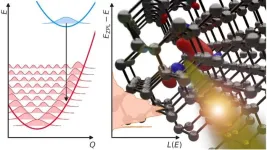A brain fingerprint: Study uncovers unique brain plasticity in people born blind
2024-07-30
(Press-News.org) WASHINGTON (July 30, 2024) — A study led by Georgetown University neuroscientists reveals that the part of the brain that receives and processes visual information in sighted people develops a unique connectivity pattern in people born blind. They say this pattern in the primary visual cortex is unique to each person — akin to a fingerprint.
The findings, described July 30, 2024, in PNAS, have profound implications for understanding brain development and could help launch personalized rehabilitation and sight restoration strategies.
For decades, scientists have known that the visual cortex in people born blind responds to a myriad of stimuli, including touch, smell, sound localization, memory recall and response to language. However, the lack of a common thread linking the tasks that activate primary areas in the visual cortex has perplexed researchers. The new study, led by Lenia Amaral, PhD, a postdoctoral researcher; and Ella Striem-Amit, PhD, the Edwin H. Richard and Elisabeth Richard von Matsch Assistant Professor of Neuroscience at Georgetown University’s School of Medicine, offers a compelling explanation: differences in how each individual’s brain organizes itself.
“We don’t see this level of variation in the visual cortex connectivity among individuals who can see — the connectivity of the visual cortex is usually fairly consistent,” said Striem-Amit, who leads the Sensory and Motor Plasticity Lab at Georgetown. “The connectivity pattern in people born blind is more different across people, like an individual fingerprint, and is stable over time — so much so that the individual person can be identified from the connectivity pattern.”
The study included a small sample of people born blind who underwent repeated functional MRI scans over two years. The researchers used a neuroimaging technique to analyze neural connectivity across the brain.
“The visual cortex in people born blind showed remarkable stability in its connectivity patterns over time,” Amaral explained. “Our study found that these patterns did not change significantly based on the task at hand — whether participants were localizing sounds, identifying shapes, or simply resting. Instead, the connectivity patterns were unique to each individual and remained stable over the two-year study period.”
Striem-Amit said these findings tell us how the brain develops. “Our findings suggest that experiences after birth shape the diverse ways our brains can develop, especially if growing up without sight. Brain plasticity in these cases frees the brain to develop, possibly even for different possible uses for the visual cortex among different people born blind,” Striem-Amit said.
The researchers posit that understanding each person’s individual connectivity may be important to better tailor solutions for rehabilitation and sight restoration to individuals with blindness, each based on their own individual brain connectivity pattern.
###
The authors report having no personal financial interests related to the study.
This work was supported by a grant from National Institutes of Health NEI/OBSSR (R01EY034515) and funds from the Edwin H. Richard and Elisabeth Richard von Matsch Distinguished Professorship in Neurological Diseases.
END
ELSE PRESS RELEASES FROM THIS DATE:
2024-07-30
FAYETTEVILLE, Ark. — Ryan Dickson, an assistant professor of horticulture for the Arkansas Agricultural Experiment Station, has been developing research since 2018 on growing blackberries indoors and recently secured a nearly $750,000 grant to further that work over the next four years.
The experiment station is the research arm of the University of Arkansas System Division of Agriculture and is home to the largest public-sector breeding program for fresh-market blackberries in the United States. ...
2024-07-30
(Santa Barbara, Calif.) — Computers benefit greatly from being connected to the internet, so we might ask: What good is a quantum computer without a quantum internet?
The secret to our modern internet is the ability for data to remain intact while traveling over long distances, and the best way to achieve that is by using photons. Photons are single units (“quanta”) of light. Unlike other quantum particles, photons interact very weakly with their environment. That stability also makes them extremely appealing for carrying quantum information over long distances, a process that requires maintaining a delicate state of entanglement for an extended ...
2024-07-30
HERSHEY, Pa. — Healthy blood vessels matter for more than just heart health. Vascular well-being is critical for brain health and potentially in addressing age-related cognitive decline and neurodegenerative disorders, like Alzheimer’s disease, according to new study led by Penn State researchers. The findings point to an understudied but possible key role the brain’s vascular network — or energy infrastructure — plays in the onset of neurodegenerative disease.
They published their work today (July 30) in Nature Communications.
Using advanced imaging techniques, the team developed maps of a mouse brain that illustrate ...
2024-07-30
HERSHEY, Pa. — Every disease is shaped by a genetic component as well as environmental factors like air pollution, climate and socioeconomic status. However, the extent to which genetics or environment plays a role in disease risk — and how much can be attributed to each — isn’t well understood. As such, the actions individuals can take to reduce their risk for disease aren’t often clear.
A team led by Penn State College of Medicine researchers found a way to tease apart genetic and ...
2024-07-30
Most Americans are aware of fake news and misinformation. In a new study, researchers from the University of Pennsylvania sought to uncover whether the threat of misinformation drives Americans to seek out news sources that reflect their own political beliefs.
The study, published in the Harvard Kennedy School Misinformation Review, found that Democrats, older individuals, and those with higher education levels are more concerned about misinformation in general and that, compared to Republicans, ...
2024-07-30
TAMPA, Fla. (July 30, 2024) – University of South Florida students are leading infection control training for fire and emergency medical services personnel as part of a groundbreaking initiative supported by a multi-million-dollar cooperative agreement with the Centers for Disease Control and Prevention.
This fall, student research and project assistants will begin swabbing first responder vehicles, ambulances, fire trucks and equipment to identify pathogen exposure risks and enhance training.
“By working on this aspect ...
2024-07-30
Today, The Grainger College of Engineering at the University of Illinois Urbana-Champaign joined other partners from around the state in officially announcing its leadership role in the Illinois Quantum and Microelectronics Park. The project – a quantum-focused research and development campus in Chicago – will be managed by a University of Illinois-led organization on behalf of the State of Illinois and Governor J.B. Pritzker.
Advances in quantum information science and engineering, together with next generation microelectronics, promise to transform computing, which underpins much of how our modern society operates. Grainger Engineering Associate Dean for Research ...
2024-07-30
There are “systemic weaknesses” in the way juries make decisions – and these are likely to be contributing to the conviction of innocent people, failures to convict the guilty, and inequalities, new research warns.
The current legal rules involving procedure and evidence are not consistently designed based on robust evidence about how the juries make decisions, but the system could function better, according to a new book.
Dr Rebecca Helm, from the University of Exeter, outlines how juries are likely to struggle to make effective legal decisions in predictable case types, including cases involving sexual offences in which testimony ...
2024-07-30
NYU Tandon School of Engineering and Indian Institute of Technology Kanpur (IIT Kanpur) have unveiled their inaugural roster of collaborative research projects, the first such initiatives under the broad partnership that NYU and IIT Kanpur established last year.
The seven projects, jointly led by researchers from each institution, aim to advance innovations across vital scientific fields including cybersecurity, biotechnology, artificial intelligence, robotics, and wireless communications.
NYU and IIT Kanpur announced their initial partnership agreement in September 2023, ...
2024-07-30
DURHAM, N.C. – Though exceedingly rare, some people diagnosed with amyotrophic lateral sclerosis (ALS) partially or fully recover from the lethal neurodegenerative disease.
A better understanding of this baffling phenomenon, reported in medical literature for at least 60 years, could point to potential new treatment approaches. To that end, researchers at Duke Health and St. Jude’s Research Hospital launched a study of ALS recovery patients and found certain genetic factors that appear to protect ...
LAST 30 PRESS RELEASES:
[Press-News.org] A brain fingerprint: Study uncovers unique brain plasticity in people born blind



